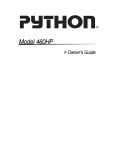Download Model 3000 ESP Owner`s Guide
Transcript
Model 3000 ESP
Owner's Guide
Limited Lifetime
Consumer Warranty
Directed Electronics, Inc. ("DEI®") promises to the original purchaser to repair or
replace with a comparable reconditioned model any DEI unit (hereafter the "unit"),
excluding without limitation the siren, the remote transmitters, the associated
sensors and accessories, which proves to be defective in workmanship or material
under reasonable use during the lifetime of the vehicle provided the following conditions are met: the unit was professionally installed and serviced by an authorized DEI
dealer; the unit will be professionally reinstalled in the vehicle in which it was originally installed by an authorized DEI dealer; and the unit is returned to DEI, shipping
prepaid with a legible copy of the bill of sale or other dated proof of purchase bearing
the following information: consumer's name, telephone number and address; the
authorized dealers name, telephone number and address; complete product description, including accessories; the year, make and model of the vehicle; vehicle license
number and vehicle identification number. All components other than the unit,
including without limitation the siren, the remote transmitters and the associated
sensors and accessories, carry a one-year warranty from the date of purchase of the
same. This warranty is non-transferable and is automatically void if: the original
purchaser has not completed the warranty card and mailed it within ten (10) days of
the date of purchase to the address listed on the card; the unit's date code or serial
number is defaced, missing or altered; the unit has been modified or used in a
manner contrary to its intended purpose; the unit has been damaged by accident,
unreasonable use, neglect, improper service, installation or other causes not arising
out of defects in materials or construction. The warranty does not cover damage to
the unit caused by installation or removal of the unit. DEI, in its sole discretion, will
determine what constitutes excessive damage and may refuse the return of any unit
with excessive damage. TO THE MAXIMUM EXTENT ALLOWED BY LAW, ALL
WARRANTIES, INCLUDING BUT NOT LIMITED TO EXPRESS WARRANTY, IMPLIED
WARRANTY, WARRANTY OF MERCHANTABILITY, FITNESS FOR PARTICULAR PURPOSE
AND WARRANTY OF NON-INFRINGEMENT OF INTELLECTUAL PROPERTY, ARE
EXPRESSLY EXCLUDED; AND DEI NEITHER ASSUMES NOR AUTHORIZES ANY PERSON
OR ENTITY TO ASSUME FOR IT ANY DUTY, OBLIGATION OR LIABILITY IN CONNECTION WITH ITS PRODUCTS. DEI DISCLAIMS AND HAS ABSOLUTELY NO LIABILITY
FOR ANY AND ALL ACTS OF THIRD PARTIES INCLUDING ITS AUTHORIZED DEALERS
OR INSTALLERS. DEI SECURITY SYSTEMS, INCLUDING THIS UNIT, ARE DETERRENTS
AGAINST POSSIBLE THEFT. DEI IS NOT OFFERING A GUARANTEE OR INSURANCE
AGAINST VANDALISM, DAMAGE OR THEFT OF THE AUTOMOBILE, ITS PARTS OR
CONTENTS; AND HEREBY EXPRESSLY DISCLAIMS ANY LIABILITY WHATSOEVER,
INCLUDING WITHOUT LIMITATION, LIABILITY FOR THEFT, DAMAGE AND/OR
© 2001 Directed Electronics, Inc.
i
VANDALISM. THIS WARRANTY DOES NOT COVER LABOR COSTS FOR MAINTENANCE,
REMOVAL OR REINSTALLATION OF THE UNIT OR ANY CONSEQUENTIAL DAMAGES OF
ANY KIND. IN THE EVENT OF A CLAIM OR A DISPUTE INVOLVING DEI OR ITS
SUBSIDIARY, THE PROPER VENUE SHALL BE SAN DIEGO COUNTY IN THE STATE OF
CALIFORNIA. CALIFORNIA STATE LAWS AND APPLICABLE FEDERAL LAWS SHALL
APPLY AND GOVERN THE DISPUTE. THE MAXIMUM RECOVERY UNDER ANY CLAIM
AGAINST DEI SHALL BE STRICTLY LIMITED TO THE AUTHORIZED DEI DEALER'S
PURCHASE PRICE OF THE UNIT. DEI SHALL NOT BE RESPONSIBLE FOR ANY
DAMAGES WHATSOEVER, INCLUDING BUT NOT LIMITED TO, ANY CONSEQUENTIAL
DAMAGES, INCIDENTAL DAMAGES, DAMAGES FOR THE LOSS OF TIME, LOSS OF
EARNINGS, COMMERCIAL LOSS, LOSS OF ECONOMIC OPPORTUNITY AND THE LIKE.
NOTWITHSTANDING THE ABOVE, THE MANUFACTURER DOES OFFER A LIMITED
WARRANTY TO REPLACE OR REPAIR THE CONTROL MODULE AS DESCRIBED ABOVE.
Some states do not allow limitations on how long an implied warranty will last or the
exclusion or limitation of incidental or consequential damages. This warranty gives
you specific legal rights and you may also have other rights that vary from State to
State.
This product may be covered by a Guaranteed Protection Plan ("GPP"). See your
authorized DEI dealer for details of the plan or call DEI Customer Service at 1-800876-0800. DEI security systems, including this unit, are deterrents against possible
theft. DEI is not offering a guarantee or insurance against vandalism, damage or theft
of the automobile, its parts or contents; and hereby expressly disclaims any liability
whatsoever, including without limitation, liability for theft, damage and/or vandalism.
DEI does not and has not authorized any person or entity to create for it any other
obligation, promise, duty or obligation in connection with this security system.
Make sure you have all of the following information from your dealer:
A clear copy of the sales receipt, showing the following:
■
■
■
■
■
■
■
■
■
ii
Date of purchase
Your full name and address
Authorized dealer's company name and address
Type of alarm installed
Year, make, model and color of the automobile
Automobile license number
Vehicle identification number
All security options installed on automobile
Installation receipts
© 2001 Directed Electronics, Inc.
Table of Contents
Limited Lifetime Consumer Warranty .
Standard Configuration . . . . . . . . . . .
What Is Included . . . . . . . . . . . . . . . .
Important Information. . . . . . . . . . . .
System Maintenance . . . . . . . . .
Your Warranty . . . . . . . . . . . . .
FCC/ID Notice . . . . . . . . . . . . .
Transmitter Functions . . . . . . . . .
Standard Configuration . . . . . . .
Expanded Configuration . . . . . . .
Using Your System . . . . . . . . . . . .
Arming . . . . . . . . . . . . . . . . .
Arming While Driving . . . . . . . .
Multi-Level Security Arming . . . .
Disarming. . . . . . . . . . . . . . . .
High Security Disarm . . . . . . . .
Disarming Without A Transmitter .
Ghost Switch. . . . . . . . . . . . . .
Silent Mode™ . . . . . . . . . . . . .
Panic Mode . . . . . . . . . . . . . . .
Valet® Mode . . . . . . . . . . . . . .
Remote Valet® . . . . . . . . . . . .
Nuisance Prevention Circuitry™ . .
Diagnostics . . . . . . . . . . . . . . . . .
Arming Diagnostics. . . . . . . . . .
Disarming Diagnostics . . . . . . . .
Table of Zones . . . . . . . . . . . . .
Code Hopping™ . . . . . . . . . . . . .
High Frequency . . . . . . . . . . . . . .
Owner Recognition . . . . . . . . . . .
Rapid Resume Logic. . . . . . . . . . .
Programming Options . . . . . . . . .
Installation Options . . . . . . . . . .
Vehicle Recovery System (VRS®) .
Arming the VRS® . . . . . . . . . . .
VRS® Triggered Sequence . . . . . .
Disarming the VRS® . . . . . . . . .
Glossary Of Terms . . . . . . . . . . . .
.
.
.
.
.
.
.
.
.
.
.
.
.
.
.
.
.
.
.
.
.
.
.
.
.
.
.
.
.
.
.
.
.
.
Security & Convenience Expansions .
Quick Reference Guide (Removable).
© 2001 Directed Electronics, Inc.
.
.
.
.
.
.
.
.
.
.
.
.
.
.
.
.
.
.
.
.
.
.
.
.
.
.
.
.
.
.
.
.
.
.
.
.
.
.
.
.
.
.
.
.
.
.
.
.
.
.
.
.
.
.
.
.
.
.
.
.
.
.
.
.
.
.
.
.
.
.
.
.
.
.
.
.
.
.
.
.
.
.
.
.
.
.
.
.
.
.
.
.
.
.
.
.
.
.
.
.
.
.
.
.
.
.
.
.
.
.
.
.
.
.
.
.
.
.
.
.
.
.
.
.
.
.
.
.
.
.
.
.
.
.
.
.
.
.
.
.
.
.
.
.
.
.
.
.
.
.
.
.
.
.
.
.
.
.
.
.
.
.
.
.
.
.
.
.
.
.
.
.
.
.
.
.
.
.
.
.
.
.
.
.
.
.
.
.
.
.
.
.
.
.
.
.
.
.
.
.
.
.
.
.
.
.
.
.
.
.
.
.
.
.
.
.
.
.
.
.
.
.
.
.
.
.
.
.
.
.
.
.
.
.
.
.
.
.
.
.
.
.
.
.
.
.
.
.
.
.
.
.
.
.
.
.
.
.
.
.
.
.
.
.
.
.
.
.
.
.
.
.
.
.
.
.
.
.
.
.
.
.
.
.
.
.
.
.
.
.
.
.
.
.
.
.
.
.
.
.
.
.
.
.
.
.
.
.
.
.
.
.
.
.
.
.
.
.
.
.
.
.
.
.
.
.
.
.
.
.
.
.
.
.
.
.
.
.
.
.
.
.
.
.
.
.
.
.
.
.
.
.
.
.
.
.
.
.
.
.
.
.
.
.
.
.
.
.
.
.
.
.
.
.
.
.
.
.
.
.
.
.
.
.
.
.
.
.
.
.
.
.
.
.
.
.
.
.
.
.
.
.
.
.
.
.
.
.
.
.
.
.
.
.
.
.
.
.
.
.
.
.
.
.
.
.
.
.
.
.
.
.
.
.
.
.
.
.
.
.
.
.
.
.
.
.
.
.
.
.
.
.
.
.
.
.
.
.
.
.
.
.
.
.
.
.
.
.
.
.
.
.
.
.
.
.
.
.
.
.
.
.
.
.
.
.
.
.
.
.
.
.
.
.
.
.
.
.
.
.
.
.
.
.
.
.
.
.
.
.
.
.
.
.
.
.
.
.
.
.
.
.
.
.
.
.
.
.
.
.
.
.
.
.
.
.
.
.
.
.
.
.
.
.
.
.
.
.
.
.
.
.
.
.
.
.
.
.
.
.
.
.
.
.
.
.
.
.
.
.
.
.
.
.
.
.
.
.
.
.
.
.
.
.
.
.
.
.
.
.
.
.
.
.
.
.
.
.
.
.
.
.
.
.
.
.
.
.
.
.
.
.
.
.
.
.
.
.
.
.
.
.
.
.
.
.
.
.
.
.
.
.
.
.
.
.
.
.
.
.
.
.
.
.
.
.
.
.
.
.
.
.
.
.
.
.
.
.
.
.
.
.
.
.
.
.
.
.
.
.
.
.
.
.
.
.
.
.
.
.
.
.
.
.
.
.
.
.
.
.
.
.
.
.
.
.
.
.
.
.
.
.
.
.
.
.
.
.
.
.
.
.
.
.
.
.
.
.
.
.
.
.
.
.
.
.
.
.
.
.
.
.
.
.
.
.
.
.
.
.
.
.
.
.
.
.
.
.
.
.
.
.
.
.
.
.
.
.
.
.
.
.
.
.
.
.
.
.
.
.
.
.
.
.
.
.
.
.
.
.
.
.
.
.
.
.
.
.
.
.
.
.
.
.
.
.
.
.
.
.
.
.
.
.
.
.
.
.
.
.
.
.
.
.
.
.
.
.
.
.
.
.
.
.
.
.
.
.
.
.
.
.
.
.
.
.
.
.
.
.
.
.
.
.
.
.
.
.
.
.
.
.
.
.
.
.
.
.
.
.
.
.
.
.
.
.
.
.
.
.
.
.
.
.
.
.
.
.
.
.
.
.
.
.
.
.
.
.
.
.
.
.
.
.
.
.
.
.
.
.
.
.
.
.
.
.
.
.
.
.
.
.
.
.
.
.
.
.
.
.
.
.
.
.
.
.
.
.
.
.
.
.
.
.
.
.
.
.
.
.
.
.
.
.
.
.
.
.
.
.
.
.
.
.
.
.
.
.
.
.
.
.
.
.
.
.
.
.
.
.
.
.
.
.
.
.
.
.
.
.
.
.
.
.
.
.
.
.
.
.
.
.
.
.
.
.
.
.
.
.
.
.
.
.
.
.
.
.
.
.
.
.
.
.
.
.
.
.
.
.
.
.
.
.
.
.
.
.
.
.
.
.
.
.
.
.
.
.
.
.
.
.
.
.
.
.
.
.
.
.
.
.
.
.
.
.
.
.
.
.
.
.
.
.
.
.
.
.
.
.
.
.
.
.
.
.
.
.
.
.
.
.
.
.
.
.
.
.
.
.
.
.
.
.
.
.
.
.
.
.
.
.
.
.
.
.
.
.
.
.
.
.
.
.
.
.
.
.
.
.
.
.
.
.
.
.
.
.
.
.
.
.
.
.
.
.
.
.
.
.
.
.
.
.
.
.
.
.
.
.
.
.
.
.
.
.
.
.
.
.
.
.
.
.
.
.
.
.
.
.
.
.
.
.
.
.
.
.
.
.
.
.
.
.
.
.
.
.
.
.
.
.
.
.
.
.
.
.
.
.
.
.
.
.
.
.
.
.
.
.
.
.
.
.
.
.
.
.
.
.
.
.
.
.
.
.
.
.
.
.
i
2
3
3
4
4
4
5
5
6
8
8
10
10
11
11
12
13
14
14
14
15
15
17
17
17
18
19
19
20
20
21
24
25
26
26
27
28
30
33
1
Standard Configuration
controls the Arm, Disarm and Panic functions.
is used for Silent Mode, Remote Valet and optional Trunk
Release.
controls an optional Auxiliary Output.
controls another optional Auxiliary Output.
and
pressed simultaneously control another optional
Auxiliary Output.
and
pressed simultaneously control another optional
Auxiliary Output.
2
© 2001 Directed Electronics, Inc.
What is Included
■
7-Channel Receiver
■
A pair of four-button transmitters
■
A Stinger® DoubleGuard® dual-output shock sensor
■
The Revenger® Soft Chirp® six-tone programmable siren
■
The red status LED indicator light
■
A push-button Valet® switch
■
Your warranty card
■
FailSafe® Starter Kill ready circuitry (may require additional labor)
Important Information
Congratulations on the purchase of your state-of-the-art vehicle
security system. This system has been designed to provide years of
trouble-free operation. Due to the complexity of this system, it
must only be installed by an authorized dealer. Installation of this
product by anyone other than an authorized dealer voids the
warranty. All dealers are provided with preprinted dealer certificates as proof of authorization.
This owner’s guide should help you to get the most out of your
system. Please take the time to read it thoroughly prior to using
this system. Additional or replacement copies of this manual may
be downloaded from the DEI® website at www.directed.com.
© 2001 Directed Electronics, Inc.
3
System Maintenance
This system requires no specific maintenance. Your remote control
is powered either by a miniature 12V battery, type GP23A, or a
lightweight 3-volt lithium battery, both of which will last approximately one year under normal use. Contact your dealer if you have
any questions. When the battery weakens, operating range will be
reduced and the LED on the remote will dim.
Your Warranty
Your warranty card must be returned and the bar code serial
number must not be removed. If the warranty card is not returned
you do not have a warranty. Make sure you receive the warranty
card from your dealer. It is also necessary to keep your proof of
purchase, which indicates that the product was installed by an authorized dealer.
FCC/ID Notice
This device complies with Part 15 of FCC rules. Operation is subject
to the following two conditions: (1) This device may not cause
harmful interference, and (2) This device must accept any interference received, including interference that may cause undesired
operation.
Caution: Changes or modifications not expressly approved by the
party responsible for compliance could void the user's authority to
operate this device.
4
© 2001 Directed Electronics, Inc.
Transmitter Functions
The receiver uses a computer-based Learn Routine to learn the
transmitter buttons. This makes it possible to assign any button on
the remote transmitter to any receiver function. Two possible
transmitter configurations are described in this section. Remember
that there are many alternate custom configurations that can be
programmed by your dealer.
Standard Configuration
The standard configuration is how the transmitters come programmed
initially. If you would like a custom configuration, contact an
authorized dealer.
Button I
The arm, disarm, and panic functions are usually controlled by
pressing
.
Button II
Silent Mode™, Remote Valet®, and optional trunk release (if
equipped) functions are usually controlled by
and Remote Valet work by pressing
. (Silent Mode
for less than one second.
Trunk release requires you to press and hold
for 1.5 seconds.)
Button III
An optional auxiliary convenience or expansion function that you
may have added to your system can be activated by pressing
.
This auxiliary output controls _____________________________.
© 2001 Directed Electronics, Inc.
5
Button IV
Another optional auxiliary convenience or expansion function that you
may have added to your system can be activated by pressing
.
This auxiliary output controls _____________________________.
Buttons I and II
Another optional auxiliary convenience or expansion function that
you may have added to your system can be activated by pressing
and
simultaneously.
This auxiliary output controls _____________________________.
Buttons III and IV
Another optional auxiliary convenience or expansion function that
you may have added to your system can be activated by pressing
and
simultaneously.
This auxiliary output controls _____________________________.
Expanded Configuration
A remote that uses the expanded configuration operates similarly
to many factory keyless entry remotes. An expanded configuration
transmitter allows you to arm, disarm, and activate Panic Mode
with separate transmitter buttons. The expanded configuration
also allows you to utilize Multi-Level Security Arming, an additional feature that cannot be utilized when using a standard
configuration transmitter. (See Multi-Level Security Arming Section
of this guide for details about this feature.) The transmitter
buttons are used for the following functions in the expanded
configuration:
6
© 2001 Directed Electronics, Inc.
Button I
The arming and Multi-Level Security functions are usually
controlled by
. Pressing
system. Pressing
for one second will arm the
again within five seconds of arming
activates Multi-Level Security.
Button II
Pressing
for one second will disarm the system. If configured
for optional progressive unlocking, pressing
when disarming
will only unlock the driver’s door. A second press of
will then
unlock the passenger doors.
Button III
Silent Mode™, Remote Valet®, and optional trunk release are all
controlled by pressing
by pressing
. Silent Mode™ and Remote Valet work
for less than one second. Pressing
for 1.5
seconds will activate the trunk release function.
Button IV
Pressing
at any time will activate Panic Mode.
Button Combinations
Four unique combinations of buttons can be assigned to control
convenience or expansion options that you may have added to
your system. Consult your authorized dealer for details.
© 2001 Directed Electronics, Inc.
7
Using Your System
The remote button numbers in this manual correspond to the
standard configuration unless otherwise specified. Remember, this
is not the only way your transmitters can be programmed. Your
transmitters may also be programmed for expanded configuration
or custom configured by a dealer to meet your needs.
Arming
You can activate, or arm, the system by pressing
for one
second. When the system arms, you will hear a short siren sound,
or chirp, and the parking lights will flash once. If the vehicle’s
power door locks have been connected to the system, the doors
will also lock.
While the system is armed, the status LED will flash approximately
twice per second, indicating that the system is actively protecting
your vehicle. If you hear a second chirp after arming and see the
status LED flashing in groups, refer to the Diagnostics section of
this guide. This extra chirp is called Bypass Notification.
The system can also be programmed to arm itself automatically
(called passive arming). If the system is programmed for passive
arming, it will automatically arm 30 seconds after the ignition is
turned off and the system detects you leaving the vehicle by
opening and closing a door. Whenever the system is in its 30second passive-arming countdown, the status LED will flash twice
8
© 2001 Directed Electronics, Inc.
as fast as it does when the system is armed. The siren will chirp
one time 20 seconds after the last door has been closed. The
system is not actually armed at that point. The system arms and
the doors lock (if connected and programmed for passive locking)
at the 30-second mark, but the siren will not chirp. The early chirp
provides you with a 10-second warning prior to arming.
NOTE: If any protected entry point (such as a door or a switch-protected
trunk or hood) is open, the system will not passively arm (unless forced
passive arming is programmed on. See Programming Options section.)
Additionally, each time a sensor is triggered during the arming
countdown, the 30-second countdown starts over.
When armed, your vehicle is protected as follows:
■
Light impacts will trigger the Warn Away® signal. When triggered, the siren will chirp and the parking lights will flash for
a few seconds.
■
Heavy impacts trigger the programmed full trigger sequence.
■
If a door is opened, the system will immediately start chirping the siren and flashing the parking lights. Three seconds
later, the siren output changes to a continuous blast. This
progressive response gives you time to disarm the system with
your transmitter if you inadvertently open the door while the
system is armed, while still providing an instant response
(even if the door is immediately closed).
■
Turning on the ignition key will trip the same two-stage
response as opening a door.
■
The optional starter kill prevents the vehicle’s starter from
cranking.
© 2001 Directed Electronics, Inc.
9
Arming While Driving
Your system can be armed while driving the vehicle! Simply press
and hold
on your transmitter for 1.5 seconds while the
vehicle is running or the ignition is on. The system will chirp once
and then once more to indicate that the ignition is on. The system
will not respond to any input except the door triggers and the
starter kill relay (if installed) will not be activated. The system will
disarm automatically when the ignition is turned off. The siren will
chirp twice and the LED will stop flashing.
Multi-Level Security Arming
Multi-Level Security Arming allows you to select which of the
system's inputs or sensors you want to be active and which you
want to be bypassed. (Refer to the Table of Zones section in this
manual.) Pressing
(only on an expanded configuration trans-
mitter) again within five seconds of arming the system will activate
Multi-Level Security. Each time
is pressed, a different security
level is selected.
Multi-Level Security provides the following levels of security:
■
Pressing
■
Press
once: The siren chirps once. The system is armed.
a second time within five seconds: The siren chirps
twice followed by a long chirp. Zones Two and Five are now
bypassed.
■
Press
a third time within five seconds: The siren chirps
three times followed by a long chirp. Zones Four and Six are
now bypassed.
10
© 2001 Directed Electronics, Inc.
■
Press
a fourth time within five seconds: The siren chirps
four times followed by a long chirp. Zones Two, Four, Five and
Six are now bypassed.
■
Press
a fifth time within five seconds: The siren chirps
five times followed by a long chirp. All input zones are now
bypassed with the exception of Zones Seven and Eight.
IMPORTANT: Multi-Level Security is only available with a system using
the expanded configuration. This feature cannot be accessed through a
standard configuration transmitter.
Disarming
To disarm the system, press
again. You will hear two chirps,
and the parking lights will flash twice. If the siren chirps either
four or five times when disarming, refer to the Diagnostics Section
of this guide. This is called Tamper Alert. If power locks are
connected to the system, the doors will unlock. The vehicle's
interior light will also illuminate for 30 seconds. The interior light
will automatically turn off if the ignition is turned on within the
30-second period.
High Security Disarm
This system proudly offers High Security Disarm. High Security
Disarm is a feature that makes it possible to silence and reset
the system when it is triggering, without disarming the system.
If the system is triggered, and the siren has been sounding for
longer than six seconds, pressing the disarm button on the
transmitter will stop the trigger and return the unit to the armed
© 2001 Directed Electronics, Inc.
11
state. The system will not disarm, but rather reset. This prevents
you from having to disable the system should you wish to stop
the triggered sequence without visually checking the vehicle.
Pressing the disarm button again, after resetting the system,
will disarm the system. Pressing the disarm button on the transmitter during the first six seconds of the triggered sequence
will disarm the system immediately. The six second timer is
provided for your convenience, in case you inadvertently trigger
the system.
Disarming Without a Transmitter
This feature allows you to disarm the system without the remote
transmitter should it be lost, damaged or disabled. In order to
disarm without a transmitter, you must have the vehicle’s ignition
key and know where the Valet switch is. Be sure to check with the
installer for the location of the Valet switch.
To disarm the security system,
turn ignition to "on" position.
Press and release the Valet
switch within 15 seconds. The
DRW-35
system should now disarm. If it does not, you may have waited too
long. Turn the ignition off and on and try again.
LOCATION OF VALET SWITCH______________________________
It is also possible to disarm the system using the Ghost Switch.
Please see the following Ghost Switch™ section of this guide.
12
© 2001 Directed Electronics, Inc.
Ghost Switch
A Ghost Switch is actually a factory switch that already exists in
your vehicle that can be set up to function as an optional
protected disarm switch. Any factory switch in your vehicle may be
used as long as it switches positive voltage. Your installer can help
you to determine which switches will work in your vehicle. Some
possible switches are power window, radio turn-on, or defroster
switches.
Once a switch has been selected, you may choose the number of
pulses (from 1 to 5) that must be applied to the switch to disarm
the system. After programming is complete, the Ghost Switch will
function as a disarm switch for both the security system and
optional VRS.
NOTE: The Valet® switch still retains its disarm capability unless the
system is programmed to Ghost Switch Only disarm mode. See
Programming Options for more details.
To use the Ghost Switch™ to disarm the system without a transmitter:
Turn on the ignition. Pulse the Ghost switch the preselected
number of times. After one second the system will disarm. If the
Ghost Switch is pulsed the incorrect number of times, you will have
to turn the ignition off and repeat the procedure. If you have not
selected the pulse count, the default count is two pulses.
NOTE: Connection of the Ghost Switch may require extra labor. Consult
with your dealer for details.
© 2001 Directed Electronics, Inc.
13
Silent Mode
To temporarily turn off the arm or disarm chirps, use Silent Mode™.
Simply press
briefly before arming or disarming, and the
confirmation chirp(s) will be eliminated for that one operation
only. If you want the arm/disarm chirps turned off permanently,
your dealer can do this for you.
NOTE: The Warn Away® response to lighter impacts is bypassed if the
system is armed using Silent Mode. This ensures that no chirps will be
emitted by the siren in an area you want chirp-free. The system is still
fully capable of triggering. Only the Warn Away response will be overridden.
Panic Mode
If you are threatened in or near your vehicle, you can attract
attention by triggering the system with your transmitter! Just
press
for 1.5 seconds, and you will enter Panic Mode. The
siren will sound and the parking lights will flash for a 30-second
period. To stop Panic Mode at any time, press
on the trans-
mitter again.
Valet Mode
You can prevent your system from automatically arming and triggering by using Valet® Mode. Valet® Mode is very useful when washing the
vehicle or having it serviced. In Valet Mode, the system will not arm,
even with the transmitter, but all optional convenience functions
(door locks, trunk release, etc.) will function normally. Remember
to check with the installer for the location of the Valet switch.
14
© 2001 Directed Electronics, Inc.
To enter or exit Valet Mode:
1. Turn the ignition on.
2. Turn the ignition off.
3. Press and release the Valet
DRW-35
switch within 10 seconds.
The status LED will light solid if you are entering Valet Mode, and
it will go out if you are exiting Valet Mode.
Remote Valet
The operations described in this section indicate transmitter
buttons that correspond to the standard configuration. Remember,
this may not be how your transmitter is set up.
1.
Open any door.
2.
Press
.
3.
Press
.
4.
Press
again.
The status LED will light solid if you are entering Valet Mode, and
it will go out if you are exiting Valet Mode.
Nuisance Prevention Circuitry
Your system has DEI®’s Nuisance Prevention® Circuitry (NPC®), which
prevents annoying repetitive trigger sequences due to faulty door
pin switches or environmental conditions such as thunder, jackhammers, airport noise, etc.
© 2001 Directed Electronics, Inc.
15
Here’s how Nuisance Prevention Circuitry works: The alarm triggers
three times. Each time, the same sensor or switch is triggering the
alarm. The three triggers activate within 60 minutes of each other.
NPC will interpret this pattern of triggers as false alarms. After the
third trigger, NPC bypasses that sensor or switch (along with any
other sensors or switches sharing the same zone) for 60 minutes.
If the bypassed sensor attempts to trigger the system while it is
being bypassed, the 60-minute bypass period will start over. This
ensures that a sensor that continuously triggers will remain
bypassed.
Doors are covered by NPC differently: If the alarm is triggered by
an open door for three full cycles (one-and-one-half minutes), the
doors will be bypassed until the trigger ceases.
NOTE: Arming and disarming the system does not reset this function! The
only ways to reset a bypassed zone are for it to not trigger for 60
minutes, or to turn on the ignition. If testing your system, it is important
to remember that the NPC programming can cause zones to be bypassed
and appear to stop working. If five chirps are heard when disarming, NPC
has been engaged. If you wish to clear the NPC memory, turn the ignition
key on.
NPC is programmable. See the “Programming Options” section of
this guide.
16
© 2001 Directed Electronics, Inc.
Diagnostics
The microprocessor at the heart of your system is constantly monitoring all of the switches and sensors connected to it. It detects
any faulty switches and sensors and prevents them from disabling
the entire system. The microprocessor will also record and report
any triggers that occurred during your absence.
Arming Diagnostics
If the system is armed while an input is active (door open, sensor
triggering, etc.) the unit will chirp once when arming and then
again a few seconds later. This is called Bypass Notification. The
system will ignore the active input until it ceases. Three seconds
later it will monitor that input normally. For example, if your car
has interior light exit delay, and you arm the system before the
interior light goes out, you may receive Bypass Notification. Once
the light goes out, however, the doors are monitored normally.
NOTE: Bypass notification will not occur when using Silent Mode™ or if
chirps have been programmed OFF.
Disarming Diagnostics
Extra disarm chirps indicate Tamper Alert. If four chirps are heard
when disarming, the system was triggered in your absence. If five
chirps are heard, a zone was triggered so many times that Nuisance
Prevention Circuitry™ has bypassed that zone. In either case, the
status LED will indicate which zone was involved (see Table of
© 2001 Directed Electronics, Inc.
17
Zones section). The system will retain this information in its
memory, and chirp four or five times each time it is disarmed, until
the next time the ignition key is turned on.
Table of Zones
The zone number is represented by the number of LED flashes used
by the system to identify a specific input. The standard input
assignments are listed below, along with spaces to write in any
optional sensors or switches you have had installed.
ZONE
(Number of
LED Flashes)
DESCRIPTION
DEALER-INSTALLED
OPTIONS
1
Instant trigger - often used
for hood/trunk pinswitches
2
Instant trigger - a heavier impact
detected by the Double Guard
Shock Sensor
3
Door switch trigger
4
Instant trigger - for optional
sensors
5
Warn Away trigger - a lighter impact
detected by the Double Guard
Shock Sensor
6
Warn Away trigger for optional sensor
7
Panic mode activated
8
Ignition trigger
NOTE: Zones 5 and 6 report to the LED when the system is disarmed.
However, they are not reported by disarming diagnostics of the siren.
18
© 2001 Directed Electronics, Inc.
Code-Hopping ®
The receiver and transmitters each use a mathematical formula
called an algorithm to change their code each time the transmitter
is used. This technology has been developed to increase the
security of the unit. The control unit detects what the next codes
should be. This helps to keep the transmitter “in sync” with the
control unit even if you use the remote control out of range of the
vehicle. However, if the transmitter has been pressed many times
out of range of the vehicle, or the battery has been removed, it
may get out of sync with the control unit and fail to operate the
system. To re-sync the remote control simply press the arm/disarm
button of the remote control several times within range of the
vehicle. The alarm will automatically re-sync and respond to the
transmitters normally.
High Frequency
Your system transmits and receives at 434 MHz. This provides a
cleaner spectrum with less interference and a more stable signal.
Enjoy a phenomenal increase in range - even in areas with high
radio interference.
© 2001 Directed Electronics, Inc.
19
Owner Recognition
Owner Recognition is a revolutionary new feature available only
from DEI®. Using a personal computer, your dealer can program
many of the system settings. The computer makes it possible to
program different settings for each transmitter that is used with
the system. Then, whenever a specific transmitter is used, the
system will recall the settings assigned to that transmitter. Owner
Recognition lets up to four users of the system have different
settings that meet their specific needs. It is almost like having four
separate alarms in your vehicle, one for each user.
NOTE: Owner Recognition cannot be programmed without the DEI Bitwriter
or personal computer and the necessary software. Check with your dealer
for more information. Additional installation labor may be required.
Rapid Resume Logic
This DEI security system is equipped with circuitry that allows the
unit to remember its alarm state if power is lost and then reconnected. If the battery is disconnected and then reconnected, the
security system will power up in the same state it was in when
power was lost. For example, if power is disconnected during a full
trigger sequence, when power is reconnected, the unit will remain
in the full trigger sequence. If power is disconnected when the unit
is disarmed, it will power back up disarmed. This also applies to
20
© 2001 Directed Electronics, Inc.
the VRS sequence. If the unit loses power at any time during the
VRS sequence, when the unit is powered back up it will automatically resume the VRS full trigger sequence.
Programming Options
Programming options control how your system performs during
normal operation; however, some options may require additional
installation parts and installation labor. Factory default program
settings are indicated in bold:
■
Active arming (transmitter only) or passive arming (automatic
arming 30-seconds after the last door has been closed).
■
Arming/disarming confirmation siren chirps on or off.
■
Passive door locking (with passive arming) or active door
locking (only when arming with the transmitter). This feature
only works if passive arming has been programmed on.
■
The ignition controlled door lock feature on or off: With this
feature on, the vehicle doors will lock 3 seconds after the
ignition is turned on, and unlock when the ignition is turned
off. The system can also be programmed to prevent the door
from locking when the ignition is turned on with any door
open. If your installer is programming the system with a
personal computer and the TechSoft Programmer, ignition
lock and unlock are independent features and can be programmed separately.
© 2001 Directed Electronics, Inc.
21
■
Panic mode enabled/disabled with the ignition on: Some
states have laws against siren capability in a moving vehicle.
■
Automatic Engine Disable (AED) on or off: The purpose of the
feature is to protect the vehicle from being stolen at all times,
regardless of whether or not the alarm is armed. If AED is programmed on, the starter of the vehicle will be disabled 30
seconds after the ignition is turned off. Once the key is turned
off, the LED will flash slowly (one-half its normal armed rate)
to indicate the AED arming cycle. Thirty seconds later, the
starter of the vehicle will be disabled. To start the vehicle, it
will be necessary to arm the car with the remote and then disarm it with the remote. It is also possible to disarm the AED
feature by turning the ignition key to the “run” position and
pressing the Valet® button once. AED is disabled when the system is in Valet® mode.
NOTE: This feature will only function if the FailSafe® Starter Kill relay has
been installed.
■
Forced passive arming on or off: If your system is programmed
for passive arming and the forced passive arming feature has
been programmed on, the system will passively arm after one
hour, even if a protected entry has been left open. This feature is useful if a door has accidentally been left ajar when
leaving the vehicle. Forced passive arming ensures that the
system will be armed in every situation.
NOTE: When the system passively arms after one hour, the entry point
that has been left open and anything connected to the same zone are
bypassed and cannot trigger the system; however, the remaining inputs
to the system are fully operational.
22
© 2001 Directed Electronics, Inc.
■
Full trigger response 30 or 60 seconds: This determines how
long the full triggered sequence lasts. Some states have laws
regulating how long a security system can sound before it is
considered a nuisance. If your installer is programming the
security system with the DEI Bitwriter or a personal computer
and the TechSoft Programmer, the full triggered response can
be programmed for any duration ranging from 1 to 180 seconds.
■
Nuisance Prevention Circuitry® on or off: Please refer to the
Nuisance Prevention Circuitry Section of this manual for a
complete explanation of how NPC operates. If NPC is programmed off, the security system will respond to inputs from
any sensor indefinitely.
NOTE: Many states have laws regulating security systems, so programming NPC off may result in your system violating state laws.
■
Progressive door trigger on or off: When the system is armed
with a door open, the system responds with ten chirps prior
to beginning the full triggered sequence. For an instant trigger, the progressive door trigger can be programmed off.
■
Standard or Ghost Switch™ Only disarm mode: In standard disarm mode, the Valet switch works in conjunction with the
optional Ghost Switch to execute disarm commands. To enhance security, Ghost Switch Only mode may be selected.
When this setting is selected, the Valet button will no longer
disarm the system. The only way you can disarm your system
(without a transmitter) is using the Ghost Switch.
■
Siren tones and chirp volume: The output of the Revenger®
Soft-Chirp® siren consists of six different tones in sequence.
© 2001 Directed Electronics, Inc.
23
Your dealer can eliminate any of these tones, resulting in a
unique, easily identifiable siren sound. Siren chirps can be
either full volume or 6 decibels quieter than full alarm blast.
Additional installation labor may be required.
Installation Options
The system has many options that may require extra parts and
labor. Some of the possibilities are listed here.
■
Progressive unlocking: In most cars with electric power door
locks, the system can be configured so that when disarmed,
only the driver’s door unlocks. A second press of the disarm
button within 15 seconds of disarming unlocks the other doors.
■
Delayed Accessory Output (DAO): The system provides an
output whenever the ignition is turned off. This output can be
used to keep the radio or power windows on when the ignition is turned off. Opening and closing a door automatically
turns the output off.
■
Vehicle Recovery System® (VRS): VRS is an anti-carjacking
device designed to help in the safe recovery of your vehicle
should you be involved in a carjacking. Please refer to the
Vehicle Recovery System section of this manual for a complete
explanation of how the Vehicle Recovery System operates.
■
Stereo or sensor on/off: The system provides outputs that can
be used to turn a stereo or sensor on and off via the remote.
24
© 2001 Directed Electronics, Inc.
Vehicle Recovery
®
System (VRS )
The optional Vehicle Recovery System feature is designed to ensure
that any unauthorized user of your vehicle (even if using your keys
and remote control) will not be able to permanently separate you
from your vehicle.
The VRS feature cannot prevent a carjacking attempt, however, it does
ensure that if your vehicle is taken by an unauthorized user, it will
be disabled (after several progressive warnings) as safely as possible.
Should a carjacking occur, the VRS allows you to concern yourself
with your personal safety without worrying about your property.
DEI® has engineered this security system, the FailSafe® Starter Kill,
and the VRS® feature to provide the best combination of personal
safety and property protection available. When properly installed, the
VRS can never inadvertently stop your vehicle in traffic, on railroad
tracks, etc., unlike some systems that can shut down your engine while
running. This system is designed to perform starter interrupt, or starter
kill. The FailSafe Starter Kill cannot shut down an already-running engine; it only prevents an engine from starting in the first place.
Any installation which allows this product to shut down a vehicle’s
engine when running is contrary to the product’s design and intended
usage, and DEI® expressly disclaims any liability resulting therefrom.
NOTE: For the VRS® system to operate it must be enabled in the programming procedure by your authorized dealer.
© 2001 Directed Electronics, Inc.
25
Arming The VRS
To arm the VRS, press the arm button on the remote while the
vehicle’s ignition is on. Once the system is armed, it will go into its
triggered sequence (see below) if any door is opened and closed. If
you are forced from the vehicle, the VRS system will trigger when
the door is opened and then closed as you leave the vehicle. This
is how the system works to combat intersection carjacking. If ordered
from the vehicle, you may arm the VRS before exiting. Arming prior
to that point, however, is highly recommended. To protect against
parking lot carjacking, simply arm the system before leaving the
vehicle. The system will now trigger automatically the next time
anyone drives the vehicle. This helps protect the vehicle if
someone takes your keys and remote by force in a parking lot.
NOTE: If the system is armed while driving and not disarmed prior to
leaving the vehicle, it is still armed and will trigger the next time the
vehicle is driven.
VRS Triggered Sequence
■
Fifteen seconds after the last door has closed, the system’s
Status LED will begin flashing. This delay allows you time to
distance yourself from your vehicle in the event of a carjacking.
■
Forty-five seconds later, the Soft Chirp® Revenger® siren will
begin chirping and the parking lights will begin flashing. This
time could be used to notify authorities that your vehicle has
been hijacked, and tell them what the VRS will do next.
■
Fifteen seconds after the siren chirps begin, the siren’s output will change to a continuous blast.
26
© 2001 Directed Electronics, Inc.
From this point forward, when the ignition key is turned off, the
VRS will immediately turn on the FailSafe starter kill. This will
prevent the vehicle from being restarted, thus immobilizing it at
that spot.
Three minutes after the constant siren output begins, the flashing
parking lights and the siren will stop. The starter kill will remain
active until the system is disarmed. If the door is opened or the
ignition is turned off and on in an attempt to restart the car, the
siren and light flashing will begin again.
Disarming The VRS
Take the time to familiarize yourself with the VRS triggering
sequence and the disarm procedure. It is important to recognize
the VRS sequence and know how to disarm it in case of accidental
activation.
Once the VRS is armed, it does not disarm automatically. You must
disarm it next time you operate the vehicle. You must manually
disarm it using the following procedure:
If the system has not entered the full
trigger sequence (siren full volume), turn
the ignition key on and press the disarm
button on the remote transmitter for one
second. The parking lights will flash and
the siren will chirp twice. The system is
now disarmed.
© 2001 Directed Electronics, Inc.
27
If the system has entered the full triggered
sequence (siren full volume), pressing the
DRW-35
disarm button of the transmitter will not
disarm VRS. You must turn the ignition to
the on position and press the Valet switch.
The system can also be disarmed by
pressing the Ghost Switch the programmed
number of times to disarm the VRS system.
NOTE: The system can be programmed by your dealer for Ghost Switch
only disarm mode. In this mode, the Valet switch will have no affect on
the VRS full trigger sequence. The optional Ghost switch must be used to
disarm the system. See your dealer for details.
Glossary of Terms
Control Unit: The “brain” of your system. Usually hidden underneath the dash area of the vehicle. It houses the microprocessor
that monitors your vehicle and controls all the alarm functions.
FailSafe® Starter Kill: An automatic switch controlled by the
system that prevents the starter from cranking whenever the system
is armed. The vehicle is never prevented from cranking when the
system is disarmed, in Valet® mode, or if the starter kill switch fails.
Installation of this feature may require additional labor.
Input: A physical connection to the system. An input can be
provided by a sensor, pinswitch or by existing systems in the
vehicle, such as ignition or courtesy lights.
28
© 2001 Directed Electronics, Inc.
LED: Red light mounted somewhere in the vehicle. It is used to
indicate the status of your system. It is also used to report
triggers and faults in the system or sensors.
Shock Sensor: This system is packaged with a DoubleGuard®
Shock Sensor. This sensor is mounted in the vehicle and designed
to pick up impacts to the vehicle or glass.
Siren: Noise generating device usually installed in the engine
compartment of the vehicle. It is responsible for generating the
“chirps” you hear, as well as the six tones you hear while the alarm
is triggered.
Transmitter: Hand-held, remote control that operates the various
system functions.
Trigger or Triggered Sequence: What happens when the alarm
“goes off” or “trips.” The triggered response of your system consists
of 30 seconds of siren sounding and parking light flashing.
Valet® Switch: A small push button switch mounted somewhere
inside the vehicle. It is used to override the alarm when the remote
transmitter is lost or damaged, or to put the system in Valet® mode.
Warn Away® Response: Lighter impacts to the vehicle will
generate the Warn Away response. It consists of several seconds of
siren chirps and parking light flashes.
Zone: A zone is a separate input that the security alarm can recognize
as unique. Each input to the security system is connected to a
particular zone. Often two or more inputs may share the same zone.
© 2001 Directed Electronics, Inc.
29
Security & Convenience
Expansions
Here we have listed only some of the many expansion options
available. Please contact your dealer for a complete explanation of
all the options available to you. All security and convenience
expansions require additional parts and labor.
Field Disturbance Sensor: An invisible dome of coverage is established by the 508D “radar” sensor. Your system can react to any
intrusions into this field with the triggered sequence.
Backup Battery: The 520T keeps the system armed, triggers the
alarm and keeps the starter kill active if the main battery is disconnected.
Electronic Hood Lock: This prevents the vehicle’s hood from being
opened whenever the system is in alarm mode, keeping thieves
away from the system’s siren, the battery connections, or other
components under the hood.
Audio Sensor: Metal on glass, glass cracking, or breaking glass
produce distinctive acoustic signatures. The 506T audio sensor
uses a microphone to pick up sounds, and then analyzes them with
proprietary acoustic software to determine if the glass has been
struck.
Power Trunk Release: The channel 2 output of the system can
operate a factory power release for the vehicle’s trunk or hatch.
(An optional relay and additional labor may be required.) If the
30
© 2001 Directed Electronics, Inc.
factory release is not power activated, DEI's 522T trunk release
solenoid can often be added.
Valet® Start System: For the ultimate in convenience, the Valet®
start system can start your vehicle, monitor engine functions, and
power your climate control system with a push of a button! Overrev protection, open-hood lockout, brake pedal shutoff, and
automatic timer shutoff are all included. (Only for automatic transmission, fuel-injected gasoline vehicles).
Power Window Control: Automatic power window control is provided with the 529T or 530T systems. These can operate power
windows, and can roll them up automatically when the system is
armed, down when you transmit channel 2 or 3, or both up and
down. The 530T also provides one touch switch operation.
Headlight and Parking Light Automation: The 545T Nite-Lite®
will automatically turn on your parking and headlights when it
gets dark. In addition, the 545T will make sure your headlights are
on whenever the windshield wipers are used. A transmitter
function can also be used to turn on your parking lights and headlights for a programmed time.
Voice Module: The 516M high quality voice module uses voice
announcements to indicate many of the system functions
including arm, disarm, Warn Away™ and channel activation.
© 2001 Directed Electronics, Inc.
31
Notes
32
© 2001 Directed Electronics, Inc.
✂
QUICK REFERENCE GUIDE:
To arm using your remote
Cut along dotted line and fold for a quick and easy reference to keep in your purse or wallet.
■ You can activate, or arm, the system by pressing
on your transmitter for one second. When the system arms, you will hear a short siren
sound, or chirp, and the parking lights will flash once. If the vehicle’s
power door locks have been connected to the system, the doors will
lock.
To disarm using your remote
■ To disarm the system, press
again. You will hear two chirps, and
the parking lights will flash twice. If power locks are connected to the
system, the doors will unlock. If the siren chirps either four or five times
when disarming, see Diagnostics section. This is called Tamper Alert.
Arming While Driving
■ Press
on your transmitter while the vehicle is running. The system
will chirp once and then once more to indicate that the ignition is on.
Disarming Without a Transmitter
■ Turn on the ignition. Push the Valet® switch within 15 seconds. The system should now disarm. If it does not, you may have waited too long,
so turn the ignition off and on and try again.
To enter or exit Valet® Mode
■ Turn ignition to “run” position, then turn to “off” position. Press and
release the Valet® switch within 10 seconds. The status LED will light
solid if you are entering Valet® Mode, and it will go out if you are exiting
Valet® Mode.
To activate panic mode
■ Hold
down for 1.5 seconds.
To exit panic mode
■ Press
on the transmitter.
To activate Silent Mode™
✂
■ Press
briefly before arming or disarming, and the confirmation
chirp(s) will be eliminated for that one operation only.
© 2001 Directed Electronics, Inc.
33
The company behind this system is Directed Electronics, Inc.
Since its inception, Directed Electronics has had one purpose, to provide consumers
with the finest vehicle security and car stereo products and accessories available. The
recipient of nearly 100 patents and Innovations Awards in the field of advanced electronic technology, Directed Electronics is ISO 9001 registered.
Quality Directed Electronics products are sold and serviced throughout North America
and around the world.
Call (800) 274-0200 for more information about our products and services.
Directed Electronics is committed to delivering
world class quality products and services
that excite and delight our customers.
Vista, CA 92083
www.directed.com
© 2001 Directed Electronics, Inc. - All rights reserved
G381 5-01 Rev. M 1.1























































